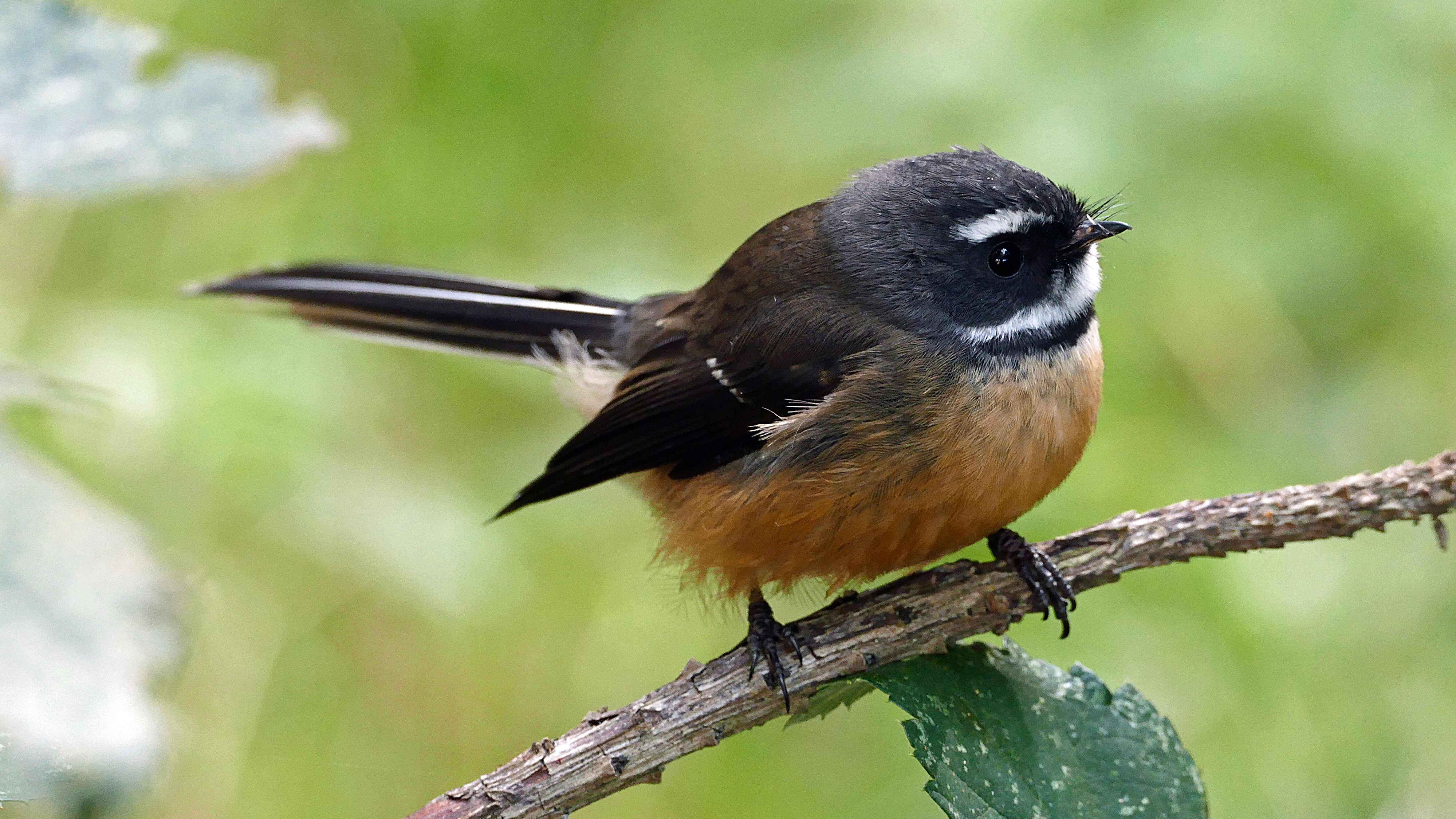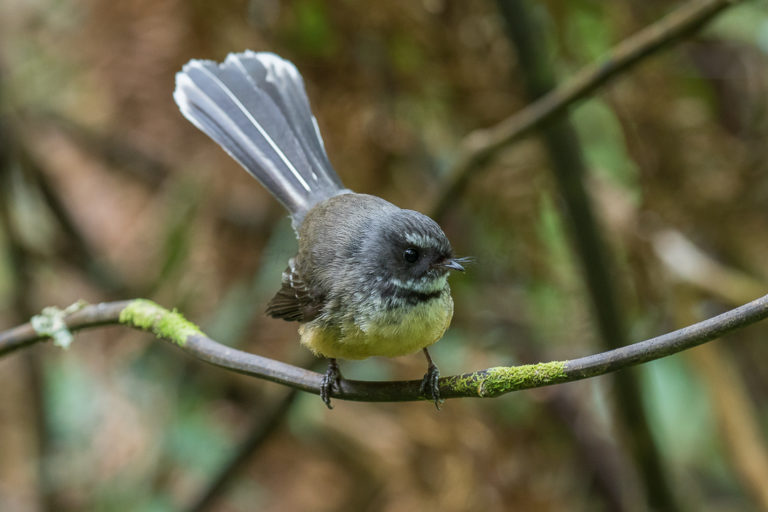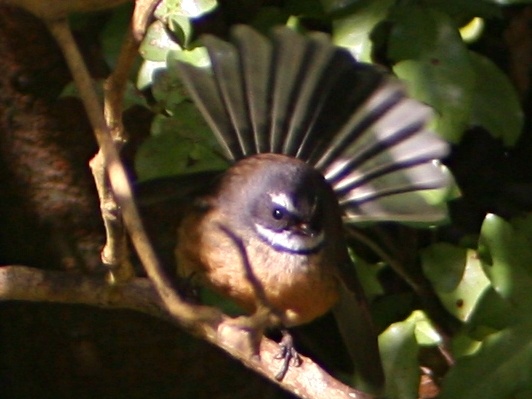Rats are bad news for nesting birds – but quantifying exactly how rat density relates to nesting success of our smallest and rarest birds is difficult for a number of reasons. They’re rare – so there’s not a lot of them to study; they are likely to live in remote locations making observation difficult and studying their nesting success may be a further pressure on their already stressed survival status. Enter the fantail.

It’s one of our smallest endemic birds – but it’s commonly seen, it lives close to humans and it isn’t endangered, so while researchers still need to minimise their impact on the nesting fantails they study (both for the good of the birds and the authenticity of their results), they don’t need to worry that their investigations will put the species at risk.
Determining how rats at various population densities affect nesting success of fantails can then give an indication of the effects they may be having on our rarer species. That was the thinking behind research carried out by Nyree Fea and Stephen Hartley from the Centre for Biodiversity and Restoration Ecology, School of Biological Sciences, Victoria University of Wellington in a paper recently published in the international journal Avian Conservation and Ecology.
“To quantify the link between ship rat abundance and survival of small, endemic birds we investigated the prevalence of rat predation on nesting New Zealand Fantails (Rhipidura fuliginosa placabilis), and its importance relative to other risk factors such as nest microsite. We surveyed 106 nests across forested reserves in Wellington City, New Zealand.”
Those reserves provided a local location with an abundance of both rats and fantails for the Wellington-based researchers.
“We aimed to (1) derive a density impact function between an index of rat abundance and an ecological outcome (nest survival of a small passerine); (2) investigate the effects of weather and observer presence on nest survival; and (3) determine the relative influence of tree-height, nest height, nest branch-width, and nest concealment on nest survival.”
Fantails were the researchers’ bird of choice for several reasons.

“We chose to monitor fantails because they are one of New Zealand’s smallest endemics birds and are known to be attacked on the nest by ship rats. Although endemic, the New Zealand Fantail is closely related to the Australian Grey Fantail, and therefore shares a fairly recent evolutionary history with native, mammalian predators. Fantails are one of New Zealand’s smallest birds and build small, light nests that could be placed beyond reach of the larger ship rat. They are also a common and widely distributed endemic species and therefore might possess resilient nesting strategies.”
The researchers indexed ship rat abundance using chew-cards placed around the nest and with tracking tunnels throughout the various reserves.
“The reserves are remnant patches of native forest with hard edges bordered by urban areas and range in area from 2–50 hectares. The forests comprise broadleaf tree species with scattered native podocarps and exotic pine trees. We monitored nests between December 2014 and February 2015, across four reserves in Wellington and again between August 2015 and February 2016, for a second, complete breeding season throughout the city (20 reserves). In the second breeding season, we adjusted our search effort to locate equal numbers of nests across reserves with moderate, low, and zero rat abundance, with rat abundance based on the first season’s tracking tunnels. Nests from this last group (zero rats) were located in Zealandia, a fenced eco-sanctuary in central Wellington from which introduced mammals, except mice, have been eliminated.”

Nests were located by following fantails exhibiting nesting behaviour and cameras were used to help observe the nests.
“We located nests by following adult fantails exhibiting nesting behaviour (collecting twigs from the ground or moss from trees, catching an insect and flying off with it in their beaks). Once a nest was sighted we ascertained its developmental stage by observing behaviour of the parents or by nestling plumage and behaviour. We estimated the days for each phase after clutch initiation as 3–6 days for laying, 13–16 days for incubation, and 11–16 days with nestling. We attached one or two cameras to trees or shrubs between 0.5 and 5.0 meters from the nest. No cameras were used if the nest was visible from a public track.”
Nest placement was of interest to researchers because it can affect both accessibility of the nest to predators and vulnerability of the nest to weather events – making nest placement a trade-off in risk factors for the birds.
“In New Zealand, agile mammals, with arboreal abilities, now pose the greatest threats to native birds. We therefore set out to investigate an additional nest placement factor, the diameter of the nest branch, a placement strategy that might limit the approach of a climbing predator. This aspect of nest site has received little attention in the literature, and we could find no examples where this has been investigated for species targeted by ship rats. Ship rats have been identified as major predators at fantail nests and these very small birds might exhibit nesting adaptations that utilize the large differences in weights between predator (average weight of an adult ship rat in New Zealand, 146 g) and prey (8 g average female fantail body weight).”
“We monitored 106 fantail nesting attempts, 67 of these were discovered at the nest-building phase, 16 at incubation stage and 23 with nestlings already present in the nest. Nests were located in 22 different tree species, especially kawakawa (22 nests), mahoe (16 nests), and karaka trees (15 nests). A total of 68 breeding pairs fledged on average of 1.3 chicks per nesting attempt; the average number of clutches per breeding pair per season was 1.6, with a maximum of four clutches in a season identified for one pair. Sixty-seven nests were monitored with cameras. Over the complete breeding season (2015–2016), fantail nesting success in unfenced urban reserves was 44.5%. For both seasons, rats were responsible for most fantail nest predations outside Zealandia (14 / 26 predations) with ship rats the only invasive mammal observed on camera.”
Some adult birds also disappeared during the course of the research.
“Although no direct observation of predation upon adult fantails was made, an adult went missing from the breeding pair after 12 of 23 nest predation events. Three avian predation events were recorded: two by the introduced blackbird and one by the native owl.”
In total, the research project modeled the effects of ship rat abundance, weather, observer impact, and attributes of the nest for their influence on nest survival.
“Fantails were more likely to abandon nests located higher in trees and those built earlier in the breeding season. More nests failed when rat abundance was higher. Where ship rat abundance reached a 25% chew-card index (CCI), the probability of the nest surviving dropped below 50%, and for CCI above 45% only 20% of nests were predicted to survive. However, Fantails also exhibited a resilient strategy that improved survival because nests located on thinner branches were less likely to suffer predation. Our research suggests that nesting strategies of fantails involve trade-offs and strategies that might protect them against one threat, might expose them to others.”
With fantail nesting success dropping to 20% when the rat chew-card index exceeds 45%, other small endemic birds are likely to be similarly impacted if they nest where rat numbers are high.
“Fantails are a common endemic species and cope with moderate levels of nest predation, however conservation of small endemic birds with less resilient breeding strategies is likely to require management of ship rat populations to low levels.”
In fact, the researchers report they had difficulty finding any fantail nests in reserves with high rat numbers.
“We were unable to model the full range of rat abundance indices in our study. We spent considerable effort trying to locate nests in sites where rat abundance was high, however only two nests were found at sites above 40% CCI. The lack of nests within such sites might reflect a lower density of breeding pairs of fantails in reserves where rat abundance is high.”
So how is it that fantails are still relatively common, when rats are having such an impact?
“Because fantail pairs that abandoned nests did not abandon a second time in the same season, it is possible that breeding pairs adjust nest placement in a reactive manner where threats are detected. New Zealand Fantails are short lived (average life span of 1 year) and adults therefore have little chance to refine nesting behavior across multiple breeding seasons. Yet, they have high renesting potential and adaptive renesting behavior can improve nesting success.”
They also have an impressive ability to raise a large number of young in spite of adversity, as a researcher back in 1966 observed.
“Blackburn (1966) observed two pairs of fantails fledging a total of 16 young in one breeding season, despite frequent predation and low nesting success (6 / 13 nests successful). The New Zealand Fantail appears to be capable of compensating for moderate levels of nest failure because the birds mature early, i.e., they are able to breed in the first year and have a high reproductive rate: two life history parameters shown to be important in determining population growth rate potential.”
What does it mean for our other, less common, small endemic birds?
“Our study shows nest survival of the New Zealand Fantail to be strongly affected by rats. Most reserves in Wellington City are under some form of management to maintain low densities of rats, yet even across this range, fantails suffered significantly heavier losses on nests located at sites where rat abundance was higher.”
“High rates of nest predation by ship rats are likely to limit populations of fantails and other small New Zealand birds that exhibit similar strategies. Populations of small, endemic birds in New Zealand forests, where high densities of invasive rats are the norm are therefore likely to be severely limited and effective conservation of this group, that evolved in the absence of mammalian predators, is likely to require ongoing management of rat populations to low levels.”
The full research report is published in Avian Conservation and Ecology and is also freely available online through Researchgate.

